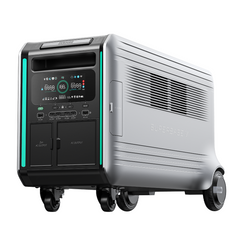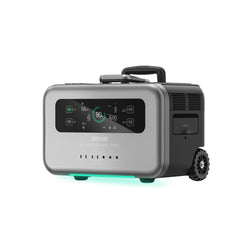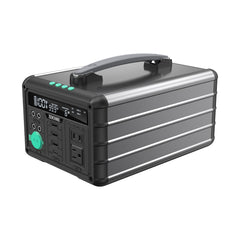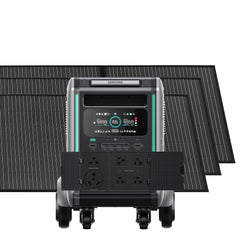You Could Apply for 30% Federal Tax Credit*,
when you Install SBV as a HomePower Solution.
Enjoy reliable and cost-effective backup power solutions for your entire home with up to 7200W of output and a massive 64kWh capacity. No need to worry about complex and expensive installations - just connect Zendure SuperBase V to your home main panel via a power inlet(NEMA L14-30P) and a transfer switch. You can also customize and take full control of your energy usage with the SuperBase V and Zendure Home Panel intergration with your home circuits. Get unlimited power with solar panels and be prepared for any blackout situation.
CHOOSE YOUR SOLUTION

Starter Solution
SuperBase V + 30 Amp Cable* + Transfer Switch
- 240V/120V Dual Voltage, 3800W output
- Base unit 4.6/6.4 kWh capacity, expands from 4.6~32 kWh, for up to a week of power supply
- Plug and Play
Our simplest and most cost-effective way to deal with temporary power failures. Connect one SuperBase V to power inlet box or tansfer switch* to supply electricity to your essential circuits (lighting, Wi-Fi router, refrigerator) when there is a blackout.
Buy Now* Work with 240V/120V transfer switch with L14-30R inlet
* 30 Amp generator cord (NEMA L14-30R 2X 5-15P) is needed to connect the Superbase V with your power inlet box and is sold separately)
* The two Male plugs of the cord must be plugged into two separated rows in SBV
*30 Amp Cable and Transfer Switch need to be purchased separately, SBV does not include these accessories
30 Amp Generator Wire (nema l14-30r 2x 5-15p) Usage Notes
1. Prior to making the connection, ensure that the SBV is in a powered-off state. After the connection is established, proceed to power on the SBV.
2. If the Y-cable becomes dislodged during operation, it is crucial to power off the SBV before re-establishing the connection.
Please purchase the 30 Amp cable and the transfer switch online, they're not launching on Zendure yet, let's expect them in the future!

Advanced Solution
2*SuperBase V + ZenY Cable + Transfer Switch
- Expands from 9.2/12.8 kWh to 46/64 kWh
- 240V/120V Dual Voltage, 7200W output
- Plug and Play
With the ZenY Cable, you can connect two Superbase V and power your whole house through your power inlet box* or transfer switch. Powerful enough to run almost any home appliance, even high-wattage ones like a dryer (5000W). You can also extend your backup power by adding Extra Batteries and Solar Panels that can keep your essentials running for weeks.
Buy Now* Work with 240V/120V transfer switch with L14-30R inlet
*ZenY cable and Transfer Switch need to be purchased separately, SBV does not include these accessories
Please purchase the transfer switch online, it hasn't launched on Zendure yet, let's expect them in the future!

Smart Control Solution
SuperBase V + Zendure Home Panel
- Expands from 4.6/6.4kWh to 46/64kWh
- 240V/120V Dual Voltage,7200W output
- Comprehensive home power management
Uninterrupted backup power supply and smart power management. Take control of your energy and reduce your electricity bills with stored energy.
Buy Now*Home Panel and Satellite Battery need to be purchased separately, SBV does not include these accessories
*Please purchase the home panel online, it hasn't launched on Zendure yet, let's expect them in the future!
Guide to the IRA Battery Storage Tax Credit in 203
Begin in January 2023, households can receive an uncapped 30% tax credit for a battery storage installation, even if it's not paired with a solar system. Here we listed some frequently asked questions and answers to them.
Do Batteries Qualify for the Solar Tax Credit?
Yes.
On Aug. 16, 2022, the IRA adds Section 48(a)(3)(A)(ix) to create an ITC for standalone energy storage technology with a minimum capacity of 3 kWh. Energy storage technology includes batteries, but it also applies more broadly to any energy storage technology that receives, stores and delivers energy for conversion to electricity, or to most technology that thermally stores energy (excluding swimming pools, combined heat and power systems, and building structural components). Energy storage installations that are placed in service after Dec. 31, 2022, and begin construction prior to Jan. 1, 2025, are entitled to the existing ITC under Section 48(a). Energy storage installations that begin construction after Dec. 31, 2024, will be entitled to credits under the technology-neutral ITC under new Section 48E (discussed below).
And it specifically addresses the Residential Clean Energy Credit for “qualified battery storage technology expenditure”
How much can I get from the battery storage tax credit?
The signing of the Inflation Reduction Act put into immediate effect the 30% Residential Clean Energy Credit, which applies to the cost of the battery and labor including the installation fee.
Can I apply for this battery tax credit if I don't have solar power system?
Yes.
Beginning on January 1, 2023, standalone battery storage (batteries that aren't connected to solar panels) will also qualify for the 30% Residential Clean Energy Credit.
So if you only purchase some batteries for energy backup, don't worry, you also can have opportunity for this apply if meet the requirements that we're going through below.
Does all battery storage qualify for the Federal Tax Credit?
To qualify for the 30% tax credit, battery storage must be:
-Installed in connection with a dwelling unit located in the United States and used as a residence by the taxpayer
-(Have) a capacity of not less than 3 kilowatt hours.
And notice that there are no maximum size, price, brand, manufacture or tax credit qualifications.
So no matter your battery are made by US or other country, you can enjoy a 30% tax credit on as large of a battery system as you’d like.
How to Claim the Federal Tax Credit?
This Residential Clean Energy Credit is a non-refundable credit that can be used to lower your federal tax liability. So it means the tax credit is not a check that comes in the mail. Actually, it’s a credit that can be used to reduce your federal tax liability beginning in the same tax year that your battery was installed and deemed operational by a government inspector.
● Determine Eligibility – Consult with your tax advisor to determine if you are eligible for the credit and have or will have sufficient tax liability to utilize the credit.
● Complete IRS Form 5695 – This form is available online and is used to claim renewable energy credits. Instructions on filling out the form are available here.
● Add The Credits To Your 1040 – Once you’ve determined you are eligible for the Residential Clean Energy Credit and you have correctly completed Form 5695, you use the total credit from Form 5695 on your Form 1040 to reduce the amount of tax you owe.
Summary
A vast majority of batteries installed between 2022 and 2032 will qualify for the solar tax credit expanded by the Inflation Reduction Act. The only qualifications specified by the Inflation Reduction Act are that the battery must be installed in a taxpayer's residence in the US, and the capacity of the battery storage must exceed 3 kWh. The 30% tax credit can be used to reduce your tax liability and can be carried forward if it's not all used at once. Even though it's available for the next 10 years, but the tax credit rate will step down, the 30% Section 25D credit lasts until Dec. 31, 2032, and then drops to 26% in 2033, and 22% in 2034. The credit is unavailable in 2035 and thereafter.
Disclaimer
You should always consult your tax professional to determine your eligibility for tax credits given your individual situation. Zendure does not guarantee any tax credit based on our products, and any information we provide is for educational purposes only and should not be considered legal advice. It does not constitute professional tax advice or financial guidance. It should not be used as the only source of information when making purchasing decisions, investment decisions, tax decisions, or execution. Consult a tax professional to evaluate your eligibility.













